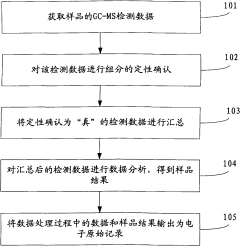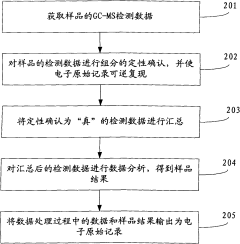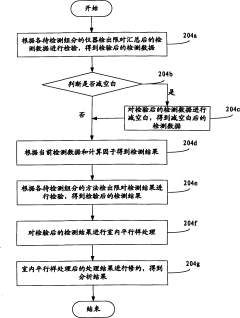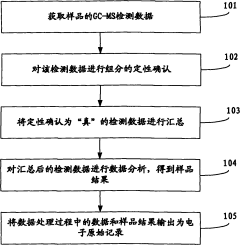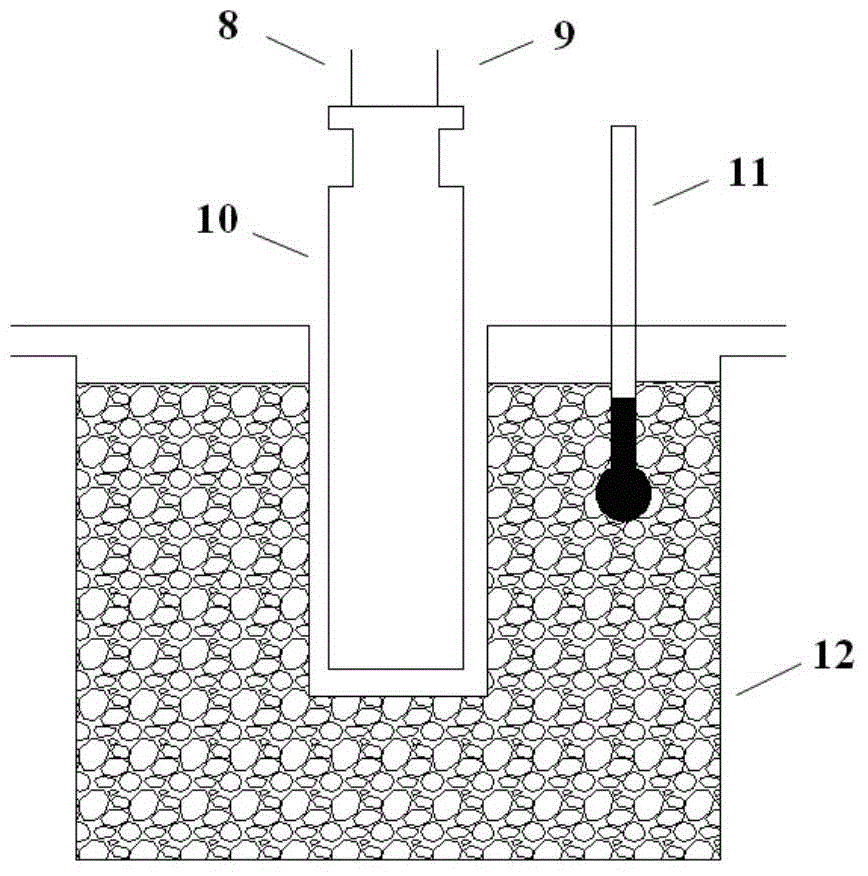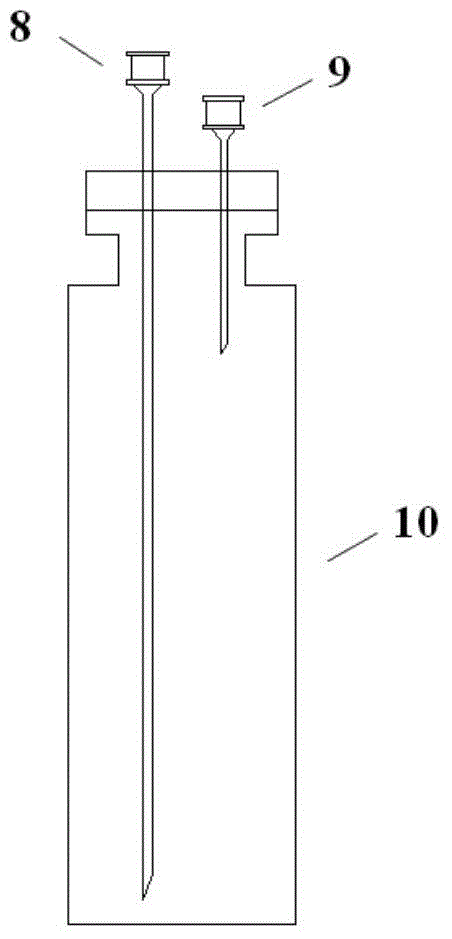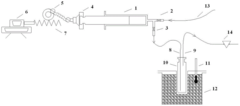Quantify Airborne Pollutants with GC-MS
SEP 22, 20259 MIN READ
Generate Your Research Report Instantly with AI Agent
Patsnap Eureka helps you evaluate technical feasibility & market potential.
GC-MS Technology Evolution and Air Monitoring Goals
Gas Chromatography-Mass Spectrometry (GC-MS) technology has evolved significantly since its inception in the 1950s, transforming from bulky laboratory equipment to more compact, sensitive, and versatile analytical instruments. The initial development focused primarily on qualitative analysis, with quantitative capabilities emerging as detector technology improved. By the 1970s, GC-MS systems began to be applied to environmental monitoring, though with limited sensitivity for many airborne pollutants.
The 1980s and 1990s witnessed substantial advancements in ionization techniques and mass analyzers, enabling detection of increasingly diverse compounds at lower concentrations. Quadrupole mass analyzers became the industry standard, offering a balance between cost, reliability, and analytical performance. The introduction of time-of-flight (TOF) mass spectrometry in the late 1990s further enhanced the capability to detect trace pollutants with improved mass resolution.
Recent technological evolution has focused on miniaturization, automation, and integration with other analytical techniques. Portable GC-MS systems have emerged, allowing for on-site monitoring of airborne pollutants rather than requiring sample transport to centralized laboratories. This shift has been crucial for real-time pollution monitoring and emergency response scenarios where immediate data is essential.
The primary goal of modern GC-MS applications in air quality monitoring is to achieve comprehensive quantification of complex mixtures of volatile organic compounds (VOCs), semi-volatile organic compounds (SVOCs), and particulate-bound compounds at environmentally and health-relevant concentrations. Current technology aims to detect pollutants in the parts-per-billion (ppb) or even parts-per-trillion (ppt) range, which is necessary for assessing compliance with increasingly stringent air quality regulations worldwide.
Another critical objective is to develop standardized methodologies that ensure consistent and comparable results across different monitoring stations and regulatory jurisdictions. This standardization is essential for creating reliable global datasets that can inform policy decisions and public health interventions.
The integration of GC-MS with continuous sampling systems represents another technological goal, moving beyond discrete sampling to provide temporal profiles of pollution events. This capability is particularly valuable for understanding pollution dynamics in urban environments and industrial settings where emissions can vary significantly throughout the day.
Looking forward, the field is trending toward multi-dimensional GC-MS systems (GCxGC-MS) that offer enhanced separation capabilities for complex environmental samples. Additionally, there is growing interest in coupling GC-MS with artificial intelligence and machine learning algorithms to improve compound identification and quantification in real-world, variable atmospheric conditions.
The 1980s and 1990s witnessed substantial advancements in ionization techniques and mass analyzers, enabling detection of increasingly diverse compounds at lower concentrations. Quadrupole mass analyzers became the industry standard, offering a balance between cost, reliability, and analytical performance. The introduction of time-of-flight (TOF) mass spectrometry in the late 1990s further enhanced the capability to detect trace pollutants with improved mass resolution.
Recent technological evolution has focused on miniaturization, automation, and integration with other analytical techniques. Portable GC-MS systems have emerged, allowing for on-site monitoring of airborne pollutants rather than requiring sample transport to centralized laboratories. This shift has been crucial for real-time pollution monitoring and emergency response scenarios where immediate data is essential.
The primary goal of modern GC-MS applications in air quality monitoring is to achieve comprehensive quantification of complex mixtures of volatile organic compounds (VOCs), semi-volatile organic compounds (SVOCs), and particulate-bound compounds at environmentally and health-relevant concentrations. Current technology aims to detect pollutants in the parts-per-billion (ppb) or even parts-per-trillion (ppt) range, which is necessary for assessing compliance with increasingly stringent air quality regulations worldwide.
Another critical objective is to develop standardized methodologies that ensure consistent and comparable results across different monitoring stations and regulatory jurisdictions. This standardization is essential for creating reliable global datasets that can inform policy decisions and public health interventions.
The integration of GC-MS with continuous sampling systems represents another technological goal, moving beyond discrete sampling to provide temporal profiles of pollution events. This capability is particularly valuable for understanding pollution dynamics in urban environments and industrial settings where emissions can vary significantly throughout the day.
Looking forward, the field is trending toward multi-dimensional GC-MS systems (GCxGC-MS) that offer enhanced separation capabilities for complex environmental samples. Additionally, there is growing interest in coupling GC-MS with artificial intelligence and machine learning algorithms to improve compound identification and quantification in real-world, variable atmospheric conditions.
Market Analysis for Airborne Pollutant Detection Systems
The global market for airborne pollutant detection systems has experienced significant growth in recent years, driven primarily by increasing environmental concerns, stricter regulatory frameworks, and growing public awareness about air quality. The market for GC-MS (Gas Chromatography-Mass Spectrometry) based detection systems specifically has shown robust expansion, with an estimated market value reaching $3.2 billion in 2022 and projected to grow at a compound annual growth rate of 6.8% through 2028.
Environmental monitoring represents the largest application segment, accounting for approximately 42% of the total market share. This is followed by industrial emission control (27%), workplace safety monitoring (18%), and research applications (13%). The dominance of environmental monitoring is attributed to government-mandated air quality monitoring programs and increasing investments in smart city initiatives worldwide.
Geographically, North America currently leads the market with a 35% share, followed closely by Europe at 32%. However, the Asia-Pacific region is witnessing the fastest growth rate at 9.2% annually, primarily driven by rapid industrialization, urbanization, and increasingly stringent environmental regulations in countries like China and India.
The customer base for GC-MS airborne pollutant detection systems is diverse, including government environmental agencies (38%), industrial corporations (29%), research institutions (17%), and commercial testing laboratories (16%). Government agencies remain the largest purchasers due to their mandate to monitor and enforce air quality standards.
Key market drivers include increasing regulatory pressure, with over 120 countries now having established national ambient air quality standards. Technological advancements enabling more portable, sensitive, and cost-effective GC-MS systems have expanded market opportunities. Additionally, growing health concerns related to air pollution, which the WHO attributes to approximately 7 million premature deaths annually, have heightened demand for accurate pollutant detection.
Market challenges include the high initial investment cost for GC-MS systems, which typically range from $50,000 to $250,000 depending on specifications. Technical complexity requiring specialized training for operation and maintenance also presents adoption barriers, particularly in emerging markets. Furthermore, competition from alternative technologies such as sensor-based systems, which offer lower cost and real-time monitoring capabilities despite reduced accuracy, is reshaping market dynamics.
The market shows strong growth potential in emerging applications such as indoor air quality monitoring, which is expected to grow at 11.3% annually following increased awareness of sick building syndrome and the COVID-19 pandemic's emphasis on indoor air quality. Mobile and wearable pollution monitoring devices represent another high-growth segment, projected to expand by 14.7% annually as consumer interest in personal environmental health monitoring rises.
Environmental monitoring represents the largest application segment, accounting for approximately 42% of the total market share. This is followed by industrial emission control (27%), workplace safety monitoring (18%), and research applications (13%). The dominance of environmental monitoring is attributed to government-mandated air quality monitoring programs and increasing investments in smart city initiatives worldwide.
Geographically, North America currently leads the market with a 35% share, followed closely by Europe at 32%. However, the Asia-Pacific region is witnessing the fastest growth rate at 9.2% annually, primarily driven by rapid industrialization, urbanization, and increasingly stringent environmental regulations in countries like China and India.
The customer base for GC-MS airborne pollutant detection systems is diverse, including government environmental agencies (38%), industrial corporations (29%), research institutions (17%), and commercial testing laboratories (16%). Government agencies remain the largest purchasers due to their mandate to monitor and enforce air quality standards.
Key market drivers include increasing regulatory pressure, with over 120 countries now having established national ambient air quality standards. Technological advancements enabling more portable, sensitive, and cost-effective GC-MS systems have expanded market opportunities. Additionally, growing health concerns related to air pollution, which the WHO attributes to approximately 7 million premature deaths annually, have heightened demand for accurate pollutant detection.
Market challenges include the high initial investment cost for GC-MS systems, which typically range from $50,000 to $250,000 depending on specifications. Technical complexity requiring specialized training for operation and maintenance also presents adoption barriers, particularly in emerging markets. Furthermore, competition from alternative technologies such as sensor-based systems, which offer lower cost and real-time monitoring capabilities despite reduced accuracy, is reshaping market dynamics.
The market shows strong growth potential in emerging applications such as indoor air quality monitoring, which is expected to grow at 11.3% annually following increased awareness of sick building syndrome and the COVID-19 pandemic's emphasis on indoor air quality. Mobile and wearable pollution monitoring devices represent another high-growth segment, projected to expand by 14.7% annually as consumer interest in personal environmental health monitoring rises.
Current Capabilities and Limitations of GC-MS for Air Analysis
Gas Chromatography-Mass Spectrometry (GC-MS) represents one of the most powerful analytical techniques for identifying and quantifying airborne pollutants. Current GC-MS systems offer detection limits in the parts per billion (ppb) to parts per trillion (ppt) range for many volatile organic compounds (VOCs), making them suitable for environmental monitoring applications. Modern instruments feature improved sensitivity through enhanced ionization techniques such as electron impact (EI) and chemical ionization (CI), allowing for more accurate identification of trace contaminants.
The separation capabilities of contemporary GC-MS systems have significantly advanced with the development of capillary columns with various stationary phases, enabling effective separation of complex mixtures of airborne pollutants. High-resolution mass spectrometers can now differentiate between compounds with nearly identical molecular weights, reducing false positives in environmental samples. Additionally, automated thermal desorption systems have streamlined the analysis process, allowing for direct sampling from air without extensive sample preparation.
Despite these capabilities, GC-MS faces several limitations when applied to air analysis. Sample collection remains challenging, particularly for reactive species that may degrade during transport or storage. Current methodologies often require concentration steps that can introduce bias or losses, especially for highly volatile or semi-volatile compounds. The technique also struggles with very polar compounds and those with high molecular weights, which may not efficiently traverse the GC column.
Time resolution presents another significant limitation, as traditional GC-MS analysis typically requires 20-60 minutes per sample, making it unsuitable for real-time monitoring applications. This temporal gap can miss transient pollution events or rapid concentration changes. Portable GC-MS systems have emerged to address field deployment needs, but they generally offer reduced sensitivity and separation efficiency compared to laboratory instruments.
Quantification accuracy is affected by matrix effects in complex air samples, where co-eluting compounds can interfere with target analyte signals. Current calibration methods often rely on standards that may not perfectly represent the complex mixtures found in ambient air. Furthermore, the technique requires specialized expertise for both operation and data interpretation, limiting widespread deployment in routine monitoring networks.
Cost considerations also constrain the application of GC-MS for comprehensive air monitoring. High-quality systems typically cost between $50,000 and $500,000, with significant ongoing maintenance expenses. This economic barrier has limited deployment primarily to research institutions, regulatory agencies, and specialized environmental monitoring firms rather than enabling widespread distributed monitoring networks.
The separation capabilities of contemporary GC-MS systems have significantly advanced with the development of capillary columns with various stationary phases, enabling effective separation of complex mixtures of airborne pollutants. High-resolution mass spectrometers can now differentiate between compounds with nearly identical molecular weights, reducing false positives in environmental samples. Additionally, automated thermal desorption systems have streamlined the analysis process, allowing for direct sampling from air without extensive sample preparation.
Despite these capabilities, GC-MS faces several limitations when applied to air analysis. Sample collection remains challenging, particularly for reactive species that may degrade during transport or storage. Current methodologies often require concentration steps that can introduce bias or losses, especially for highly volatile or semi-volatile compounds. The technique also struggles with very polar compounds and those with high molecular weights, which may not efficiently traverse the GC column.
Time resolution presents another significant limitation, as traditional GC-MS analysis typically requires 20-60 minutes per sample, making it unsuitable for real-time monitoring applications. This temporal gap can miss transient pollution events or rapid concentration changes. Portable GC-MS systems have emerged to address field deployment needs, but they generally offer reduced sensitivity and separation efficiency compared to laboratory instruments.
Quantification accuracy is affected by matrix effects in complex air samples, where co-eluting compounds can interfere with target analyte signals. Current calibration methods often rely on standards that may not perfectly represent the complex mixtures found in ambient air. Furthermore, the technique requires specialized expertise for both operation and data interpretation, limiting widespread deployment in routine monitoring networks.
Cost considerations also constrain the application of GC-MS for comprehensive air monitoring. High-quality systems typically cost between $50,000 and $500,000, with significant ongoing maintenance expenses. This economic barrier has limited deployment primarily to research institutions, regulatory agencies, and specialized environmental monitoring firms rather than enabling widespread distributed monitoring networks.
Established GC-MS Methodologies for Airborne Pollutant Quantification
01 GC-MS quantification methods and techniques
Various methods and techniques for quantitative analysis using Gas Chromatography-Mass Spectrometry (GC-MS) have been developed. These methods involve specific sample preparation protocols, chromatographic separation conditions, and mass spectrometric detection parameters to achieve accurate quantification of target compounds. The techniques often include internal standardization, calibration curves, and specialized data processing algorithms to enhance the precision and reliability of quantitative measurements.- GC-MS Instrumentation and System Design: Various designs and improvements in GC-MS instrumentation focus on enhancing quantification capabilities. These include specialized ion source configurations, detector systems, and integrated hardware components that improve sensitivity, resolution, and reproducibility of quantitative measurements. Advanced system designs incorporate automated calibration mechanisms and optimize the interface between gas chromatography and mass spectrometry components to minimize analyte loss and maximize detection efficiency.
- Quantification Methods and Algorithms: Specialized algorithms and computational methods have been developed for accurate quantification of compounds using GC-MS data. These include advanced peak integration techniques, statistical models for handling complex matrices, and machine learning approaches for automated quantification. Methods incorporate internal standard calibration, isotope dilution techniques, and multi-point calibration curves to ensure accurate and reliable quantitative results across different concentration ranges and sample types.
- Sample Preparation Techniques for Quantitative Analysis: Effective sample preparation methods are critical for accurate GC-MS quantification. These include extraction procedures, derivatization techniques, and clean-up protocols designed to maximize analyte recovery while minimizing matrix interference. Specialized approaches for different sample types (biological, environmental, industrial) ensure optimal extraction efficiency and sample stability prior to analysis, directly impacting the accuracy and precision of quantitative measurements.
- Targeted Quantification of Specific Compounds: Methods specifically developed for quantifying particular classes of compounds or analytes in complex matrices. These approaches include selective ion monitoring techniques, specialized derivatization procedures for specific functional groups, and optimized chromatographic conditions for target compounds. Applications range from pharmaceutical metabolite analysis to environmental contaminant monitoring, with each method tailored to the chemical properties of the target analytes to achieve optimal sensitivity and selectivity.
- Quality Control and Validation Procedures: Comprehensive quality control and validation protocols ensure the reliability of GC-MS quantification results. These include procedures for determining method detection limits, quantification limits, linearity ranges, and measurement uncertainty. Validation approaches incorporate robustness testing, inter-laboratory comparisons, and certified reference materials to establish method performance characteristics. Quality assurance measures address instrument calibration, system suitability testing, and ongoing performance verification to maintain quantitative accuracy over time.
02 GC-MS instrumentation and system optimization
Specialized instrumentation and system configurations for GC-MS quantification have been designed to improve analytical performance. These systems incorporate advanced components such as high-efficiency columns, sensitive detectors, and automated sample introduction devices. System optimization approaches include tuning of mass spectrometer parameters, optimization of chromatographic conditions, and integration of data acquisition systems to enhance sensitivity, selectivity, and reproducibility for quantitative analysis.Expand Specific Solutions03 Sample preparation techniques for GC-MS quantification
Effective sample preparation methods are crucial for accurate GC-MS quantification. These techniques include extraction procedures (liquid-liquid extraction, solid-phase extraction), derivatization methods to enhance volatility and detection sensitivity of target analytes, clean-up protocols to remove matrix interferences, and concentration steps to improve detection limits. The choice of sample preparation technique depends on the sample matrix and the target analytes to be quantified.Expand Specific Solutions04 Application-specific GC-MS quantification methods
GC-MS quantification methods have been developed for specific applications across various fields including environmental analysis, food safety, pharmaceutical testing, forensic science, and metabolomics. These methods are tailored to address the unique challenges associated with each application, such as complex matrices, trace-level detection requirements, or the need for multi-component analysis. Application-specific methods often involve specialized sample preparation, chromatographic conditions, and detection parameters optimized for particular analytes.Expand Specific Solutions05 Data processing and analysis for GC-MS quantification
Advanced data processing and analysis techniques are essential for accurate GC-MS quantification. These include automated peak integration algorithms, deconvolution methods for overlapping peaks, statistical approaches for method validation, and specialized software tools for data interpretation. Machine learning and artificial intelligence approaches are increasingly being applied to process complex GC-MS datasets, improving the accuracy and efficiency of quantitative analysis while reducing manual data processing requirements.Expand Specific Solutions
Leading Manufacturers and Research Institutions in GC-MS Technology
The airborne pollutant quantification market using GC-MS technology is in a growth phase, with increasing regulatory demands driving market expansion. Major players form a competitive landscape dominated by established analytical instrument manufacturers like Agilent Technologies, Shimadzu Corporation, and LECO Corp, alongside specialized research institutions such as Shanghai Research Institute of Chemical Industry and Dalian Institute of Chemical Physics. The market exhibits regional clusters in China, Japan, and the US, with varying technological maturity levels. Chinese institutions are rapidly advancing capabilities, while Western companies maintain technological leadership through continuous innovation in sensitivity, automation, and data processing. The integration of AI and IoT technologies is creating new competitive dimensions in this approximately $2.5 billion market.
Hitachi Ltd.
Technical Solution: Hitachi has developed the Chromaster GC-MS system specifically enhanced for environmental pollutant analysis. Their technology incorporates a unique ion source design that improves ionization efficiency by approximately 30% for difficult-to-ionize airborne compounds. Hitachi's Smart Environmental Analysis Package includes automated sample preparation modules that reduce manual handling by up to 70%, minimizing contamination risks in trace analysis. Their proprietary ion optics system achieves sub-ppb detection limits for priority air pollutants while maintaining linearity across 5 orders of magnitude. Hitachi has also pioneered miniaturized GC-MS systems for field deployment, reducing instrument size by approximately 60% compared to conventional laboratory systems while maintaining comparable analytical performance. Their integrated data management platform features AI-assisted peak identification algorithms that can reduce false positives by up to 40% compared to conventional library search methods, particularly valuable for complex airborne samples with multiple interfering compounds.
Strengths: Excellent reliability and robustness for routine monitoring applications; compact design options for field deployment; simplified operation for non-specialist users; strong integration with automated sampling systems. Weaknesses: Somewhat lower sensitivity than top-tier research-grade systems; more limited compound database compared to some competitors; fewer specialized environmental applications developed compared to market leaders.
Agilent Technologies, Inc.
Technical Solution: Agilent Technologies has developed comprehensive GC-MS solutions specifically designed for airborne pollutant quantification. Their flagship 8890/5977B GC-MS system incorporates advanced electron ionization (EI) source technology that delivers up to 10x greater sensitivity compared to conventional systems, enabling detection of trace-level volatile organic compounds (VOCs) and semi-volatile organic compounds (SVOCs) in air samples. Agilent's MassHunter software suite features specialized environmental analysis workflows with automated data processing capabilities that reduce analysis time by approximately 60%. Their Multimode Inlet (MMI) technology allows for large volume injection, increasing sensitivity by 2-3 orders of magnitude for challenging airborne compounds. Agilent has also pioneered the development of specialized columns like the DB-VRX and DB-624Ultra that provide superior separation of complex airborne pollutant mixtures with improved peak shapes and reduced column bleed, enhancing quantification accuracy by up to 25%.
Strengths: Industry-leading sensitivity and selectivity for trace pollutant detection; comprehensive software solutions for environmental analysis; extensive application support and method development resources. Weaknesses: Higher initial investment cost compared to some competitors; complex systems may require specialized training; consumables can be relatively expensive for routine monitoring applications.
Key Innovations in Sample Collection and Analytical Protocols
Data processing method of gas chromatography-mass spectrometry (GC-MS) analysis
PatentActiveCN102466662A
Innovation
- Provide a data processing method for GC-MS analysis. Through fast batch import, qualitative confirmation and data summary, VBA macro code is used to realize data analysis and output in EXCEL application, ensuring the accuracy and reversible reproduction of electronic original records.
Low-temperature pressurization head space sample injection device for measuring volatile substances in atmosphere through GC-MS (gas chromatography-mass spectrometer) technology
PatentActiveCN103558322A
Innovation
- A low-temperature pressurized headspace sampling device is used, including a reciprocating all-glass piston pump, headspace bottle and cooling equipment. The low-temperature pressurized extraction and enrichment of samples is achieved through a one-way valve and a micro motor to ensure airtightness and sampling Reproducibility of conditions.
Environmental Regulations and Compliance Standards
The regulatory landscape governing airborne pollutant monitoring using GC-MS technology has evolved significantly over the past decades. The Clean Air Act (CAA) in the United States and similar frameworks in the European Union, such as the Air Quality Directive (2008/50/EC), establish comprehensive requirements for monitoring and controlling airborne pollutants. These regulations specifically mandate the quantification of volatile organic compounds (VOCs), particulate matter, and other hazardous air pollutants using approved methodologies, with GC-MS being a primary analytical technique recognized for its precision and reliability.
The EPA Method TO-15 specifically addresses the analysis of VOCs in ambient air using GC-MS, requiring detection limits in the parts per billion by volume (ppbv) range. Similarly, the European standard EN 14662 outlines procedures for benzene measurements using GC-MS techniques. These standards not only specify the analytical methods but also dictate sampling protocols, quality assurance procedures, and data reporting requirements to ensure consistency and comparability of results across different monitoring stations.
Compliance thresholds vary significantly by jurisdiction and pollutant type. For instance, benzene exposure limits range from 1 ppb in some European countries to 5 ppb in the United States. These variations reflect different risk assessment approaches and socioeconomic considerations in environmental policy development. Industrial facilities utilizing GC-MS for compliance monitoring must adhere to strict calibration schedules, typically requiring quarterly performance evaluations and annual audits by certified third parties.
Recent regulatory trends indicate a movement toward more stringent standards, particularly for emerging contaminants of concern such as per- and polyfluoroalkyl substances (PFAS) in airborne particulates. The implementation of these regulations has driven technological advancements in GC-MS instrumentation, including improved sensitivity, automation capabilities, and real-time monitoring solutions that enable continuous compliance verification rather than periodic sampling.
International harmonization efforts, led by organizations such as the International Organization for Standardization (ISO) and the World Health Organization (WHO), aim to establish globally recognized methodologies for airborne pollutant quantification. The ISO 16000 series specifically addresses indoor air quality assessment methods, including GC-MS applications, while WHO air quality guidelines provide health-based exposure thresholds that inform national regulatory frameworks.
Regulatory compliance increasingly requires not only accurate quantification but also comprehensive data management systems that ensure traceability, transparency, and timely reporting. Modern GC-MS systems integrated with laboratory information management systems (LIMS) facilitate automated compliance reporting, reducing administrative burden while improving data integrity and auditability in accordance with regulatory expectations.
The EPA Method TO-15 specifically addresses the analysis of VOCs in ambient air using GC-MS, requiring detection limits in the parts per billion by volume (ppbv) range. Similarly, the European standard EN 14662 outlines procedures for benzene measurements using GC-MS techniques. These standards not only specify the analytical methods but also dictate sampling protocols, quality assurance procedures, and data reporting requirements to ensure consistency and comparability of results across different monitoring stations.
Compliance thresholds vary significantly by jurisdiction and pollutant type. For instance, benzene exposure limits range from 1 ppb in some European countries to 5 ppb in the United States. These variations reflect different risk assessment approaches and socioeconomic considerations in environmental policy development. Industrial facilities utilizing GC-MS for compliance monitoring must adhere to strict calibration schedules, typically requiring quarterly performance evaluations and annual audits by certified third parties.
Recent regulatory trends indicate a movement toward more stringent standards, particularly for emerging contaminants of concern such as per- and polyfluoroalkyl substances (PFAS) in airborne particulates. The implementation of these regulations has driven technological advancements in GC-MS instrumentation, including improved sensitivity, automation capabilities, and real-time monitoring solutions that enable continuous compliance verification rather than periodic sampling.
International harmonization efforts, led by organizations such as the International Organization for Standardization (ISO) and the World Health Organization (WHO), aim to establish globally recognized methodologies for airborne pollutant quantification. The ISO 16000 series specifically addresses indoor air quality assessment methods, including GC-MS applications, while WHO air quality guidelines provide health-based exposure thresholds that inform national regulatory frameworks.
Regulatory compliance increasingly requires not only accurate quantification but also comprehensive data management systems that ensure traceability, transparency, and timely reporting. Modern GC-MS systems integrated with laboratory information management systems (LIMS) facilitate automated compliance reporting, reducing administrative burden while improving data integrity and auditability in accordance with regulatory expectations.
Data Integration and IoT Solutions for Continuous Monitoring
The integration of IoT (Internet of Things) technologies with GC-MS (Gas Chromatography-Mass Spectrometry) systems represents a significant advancement in continuous air quality monitoring capabilities. Modern IoT frameworks enable real-time data collection from distributed GC-MS units, creating comprehensive pollution monitoring networks across urban and industrial environments.
These integrated systems typically employ edge computing capabilities that allow for preliminary data processing directly at the monitoring site. This approach reduces data transmission loads while enabling immediate detection of threshold exceedances for critical pollutants. The architecture generally consists of sensor nodes equipped with miniaturized GC-MS technology, wireless communication modules, and centralized cloud platforms for data aggregation and analysis.
Data standardization protocols such as OGC SensorThings API and IEEE 1451 have emerged as crucial elements in these systems, ensuring interoperability between diverse monitoring equipment and analytical platforms. These standards facilitate seamless data exchange across heterogeneous networks while maintaining data integrity throughout the monitoring ecosystem.
Advanced machine learning algorithms incorporated into these systems enable pattern recognition in pollution data, identifying emission sources and predicting concentration trends with increasing accuracy. Temporal and spatial analysis capabilities allow for the correlation of pollution events with meteorological conditions, traffic patterns, and industrial activities.
Security considerations have become paramount in IoT-based monitoring networks, with encryption protocols and access control mechanisms protecting sensitive environmental data from unauthorized access or manipulation. Many systems now implement blockchain technology to ensure data immutability and establish clear audit trails for regulatory compliance.
The deployment of digital twin technology represents the cutting edge of these integrated solutions, creating virtual replicas of monitoring environments that enable sophisticated simulation and predictive modeling. These digital twins facilitate scenario testing and optimization of monitoring strategies without disrupting operational systems.
Cost-effectiveness has improved significantly through the implementation of energy harvesting technologies and low-power communication protocols like LoRaWAN and NB-IoT, extending the operational lifespan of remote monitoring stations while reducing maintenance requirements. Cloud-based subscription models have further democratized access to sophisticated analytical capabilities, allowing smaller municipalities and organizations to implement comprehensive monitoring programs.
These integrated systems typically employ edge computing capabilities that allow for preliminary data processing directly at the monitoring site. This approach reduces data transmission loads while enabling immediate detection of threshold exceedances for critical pollutants. The architecture generally consists of sensor nodes equipped with miniaturized GC-MS technology, wireless communication modules, and centralized cloud platforms for data aggregation and analysis.
Data standardization protocols such as OGC SensorThings API and IEEE 1451 have emerged as crucial elements in these systems, ensuring interoperability between diverse monitoring equipment and analytical platforms. These standards facilitate seamless data exchange across heterogeneous networks while maintaining data integrity throughout the monitoring ecosystem.
Advanced machine learning algorithms incorporated into these systems enable pattern recognition in pollution data, identifying emission sources and predicting concentration trends with increasing accuracy. Temporal and spatial analysis capabilities allow for the correlation of pollution events with meteorological conditions, traffic patterns, and industrial activities.
Security considerations have become paramount in IoT-based monitoring networks, with encryption protocols and access control mechanisms protecting sensitive environmental data from unauthorized access or manipulation. Many systems now implement blockchain technology to ensure data immutability and establish clear audit trails for regulatory compliance.
The deployment of digital twin technology represents the cutting edge of these integrated solutions, creating virtual replicas of monitoring environments that enable sophisticated simulation and predictive modeling. These digital twins facilitate scenario testing and optimization of monitoring strategies without disrupting operational systems.
Cost-effectiveness has improved significantly through the implementation of energy harvesting technologies and low-power communication protocols like LoRaWAN and NB-IoT, extending the operational lifespan of remote monitoring stations while reducing maintenance requirements. Cloud-based subscription models have further democratized access to sophisticated analytical capabilities, allowing smaller municipalities and organizations to implement comprehensive monitoring programs.
Unlock deeper insights with Patsnap Eureka Quick Research — get a full tech report to explore trends and direct your research. Try now!
Generate Your Research Report Instantly with AI Agent
Supercharge your innovation with Patsnap Eureka AI Agent Platform!
